Archive:Population change at regional level
This Statistics Explained article is outdated and has been archived - for recent articles on population see here.
- Data from March 2011. Most recent data: Further Eurostat information, Main tables and Database.
This article presents the current regional pattern of population changes in the European Union (EU), resulting from natural population change or migration; at present migration is the major factor. Demographic trends have a strong impact on EU societies and pose huge challenges in all policy areas. Therefore, detailed statistical information is essential for policy makers and citizens alike.
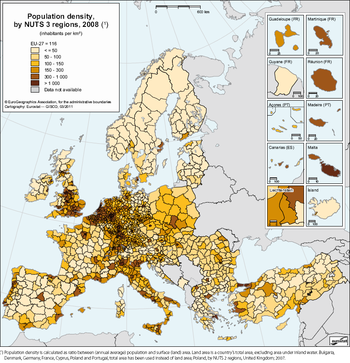
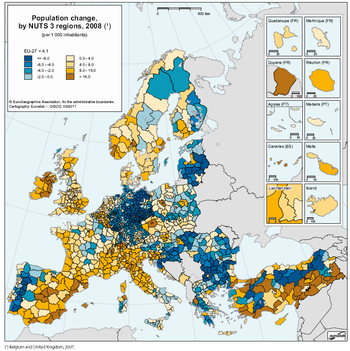

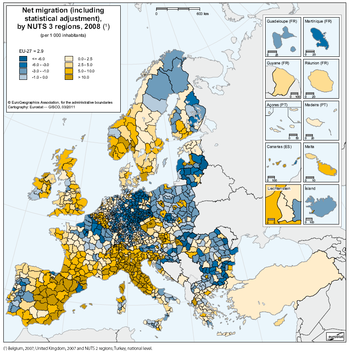
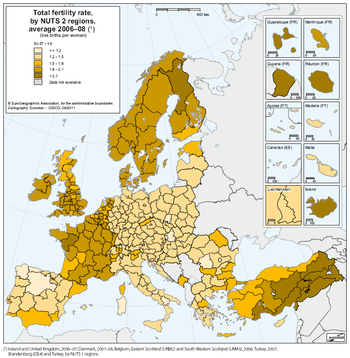
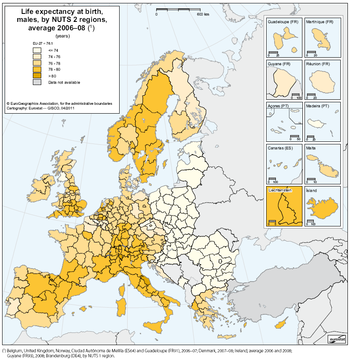

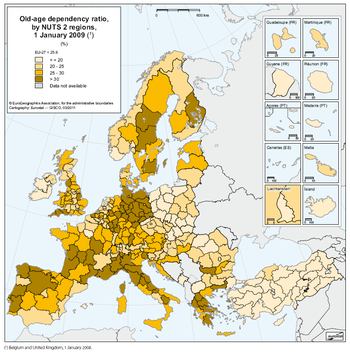
Main statistical findings
Population size and density
On 1 January 2009, 499.7 million people inhabited the 27 Member States of the European Union. The population density at EU-27 level in 2008 was estimated at 116 inhabitants per km2.
Map 1 shows the population density in 2008. Generally, the NUTS 3 regions that include the capital city of the country, and in most cases the regions in their immediate vicinity, are among the most densely populated.
The NUTS 3 region of Paris was by far the most densely populated (21 022 inhabitants per km2), followed by Inner London West (10 094) and Inner London East (9 049). Population densities above 5 000 per km2 were observed, in decreasing order, in the following NUTS 3 regions: Hauts-de-Seine (France), Bucureşti (Romania), Brussel-Hoofdstad/Bruxelles-Capitale (Belgium), Seine-Saint-Denis and Val-de-Marne (France), Melilla (Spain) and Basel-Stadt (Switzerland).
The least densely populated level-3 statistical region within the territory covered in 2008 was Landsbyggd (Iceland) with 1.2 inhabitants per km2. Within the EU-27, the least densely populated NUTS 3 region was Guyane (France) with 2.7 inhabitants per km2.
Population change in 2008
Population change in a given reference year is the difference between the population size on 1 January of the following year and on 1 January of the given reference year. Changes in the size of population are the result of the number of births and deaths and of the number of people migrating inward and outward. Population change therefore consists of two components: ‘natural change’ (the difference between live births and deaths) and ‘net migration and statistical adjustment’ (see Data sources and availability).
Maps 2, 3 and 4 present population change and these two components in 2008, by NUTS 3 regions. For comparability, population change and its two components are presented as crude rates per 1 000 inhabitants, i.e. relative to the size of the average population of the region (see Data sources and availability).
The maps show how the population change varies across regions from growth to decline (Map 2) due to positive or negative natural change (Map 3) and positive or negative net migration and statistical adjustment (Map 4).
The current demographic situation in the EU-27 confirms a trend of continuing growth, which has been unbroken since 1960. The population of the EU-27 grew by 4.1 per 1 000 inhabitants in 2008, due to a natural increase (see Data sources and availability) of 1.2 per 1 000 inhabitants and net migration[1] of 2.9 per 1 000 inhabitants. Although the population of the EU-27 as a whole increased in 2008, this population change was unevenly distributed across the Member States. In 2008, the population increased in 20 EU Member States and declined in the other seven.
The population decline was seen in most of the north-eastern and eastern and part of the south-eastern NUTS 3 regions. The countries with regions most affected by this trend in 2008 were Bulgaria, Germany, Hungary, Romania, Poland, Estonia, Latvia, Lithuania and Croatia, where the population declined in most of their NUTS 3 regions and outpaced the population growth observed in their other regions. A decline in population was also evident in the northern parts of Sweden, in the Finnish region of Itä-Suomi, in many regions of Greece and Portugal and in several regions of Turkey. On the other hand, the population grew in Cyprus, Luxembourg and Malta, and in Montenegro, the former Yugoslav Republic of Macedonia and, to a greater extent, in Turkey.
In nearly all western and south-western regions of the EU, the population increased during 2008. This is particularly evident in Ireland and in almost every region of the United Kingdom, in Italy, Spain, France, including the French overseas departments, and in the Spanish and Portuguese islands in the Atlantic Ocean. Positive population changes were also recorded in Austria, Switzerland, Belgium, Luxembourg and the Netherlands.
The picture provided by Map 2 can be sharpened by analysing the two components of population change, i.e. natural change and net migration[2].
Map 3 shows that, in many regions of the EU, more people died than were born in 2008. The resulting negative natural population change is widespread and affects almost half the regions in the EU. A positive natural change in population can be identified across Ireland, the central parts of the United Kingdom, most regions in France, Belgium, Luxembourg, the Netherlands, Switzerland, Iceland, Liechtenstein and Denmark and most regions of Norway. In all these regions, there were more live births than deaths in 2008.
Deaths outnumbered births in most regions of Germany, in Hungary, Croatia, Romania and Bulgaria and also in the Baltic Member States in the north and Greece and Italy in the south. Other countries showed a more balanced pattern overall.
One major reason for the slowdown in the natural growth of the population is that the EU’s inhabitants are having fewer children than they used to. At aggregate level, in the 27 countries that form the EU today, the total fertility rate has declined from around 2.5 live births per woman in the early 1960s to 1.60 for the period 2006–08. (For the definition of total fertility rate, (see Data sources and availability).
At national level, over the period 2006–08, a total fertility rate lower than 1.5 children per woman was observed in 17 of the 27 Member States. In the developed parts of the world today, a total fertility rate of around 2.1 live births per woman is considered to be the replacement rate, i.e. the level at which the population would remain stable in the long run if there were no inward or outward migration. Between 2006 and 2008 practically all of the EU, EFTA and candidate countries, with the exception of Turkey and Iceland, were still well below this replacement rate.
Map 5 shows the variation in the total fertility rate by NUTS 2 regions. Among the 317 NUTS 2 regions covered in this analysis, over the period 2006–08 the total fertility rate ranged, on average, from one child per woman in Asturias in Spain to 3.7 children in the French overseas department of Guyane.
Life expectancy at birth has risen by about 10 years over the last 50 years, due to improved socio-economic and environmental conditions and better medical treatment and care.
Maps 6 and 7 give a picture of the average male and female life expectancy at birth over the period 2006–08 for the NUTS 2 regions. The two maps are directly comparable thanks to the common colour patterns used to classify male and female life expectancy.
In every region, women live longer than men. At EU-27 level, life expectancy at birth averaged 82.2 years for women and 76.1 for men, giving a gender gap of 6.1 years.
The regional data revealed marked differences between the lowest and highest values for females and males. The lowest values were 76.0 years for females (Vest and Nord-Vest regions of Romania and the Yugoiztochen and Severozapaden regions of Bulgaria) and 65.5 years for males (Lithuania). The highest values for life expectancy at birth were 86.0 years for females and 80.2 years for males, both recorded in the Ticino region of Switzerland.
Map 6 shows that life expectancy at birth for males is less than or equal to 74 years mostly in the eastern part of the EU-27, covering all regions of the Baltic States, Poland, Slovakia, Hungary, Romania, Bulgaria, the former Yugoslav Republic of Macedonia and Montenegro and a few regions of the Czech Republic, Portugal and Croatia, whereas values higher than 80 years were observed in Åland (Finland) and Ticino (Switzerland). Map 7 depicts the regional distribution of life expectancy at birth for females, with values less than or equal to 78 years mainly in the eastern part of Europe, including all regions of Latvia, Lithuania, Romania, Bulgaria, the former Yugoslav Republic of Macedonia and Montenegro, and in most regions of Hungary. Values higher than 84 years were observed in a large number of regions of Spain, France and Italy, in the Salzburg region of Austria and in Switzerland and Liechtenstein.
The smallest gender gap was 3.4 years in the Åland region of Finland, while the largest was 11.8 years in Lithuania.
The third determinant of population change (after fertility and mortality) is net migration. As many countries in the EU are currently at a point in the demographic development where natural population change is close to being balanced or negative, net migration is becoming more significant for maintaining the size of the population. Moreover, migration contributes indirectly to natural growth, given that migrants have children. Migrants are also usually younger and have not yet reached the age at which the probability of dying is higher.
Map 4 shows net migration (including statistical adjustment) in 2008 by NUTS 3 region across the EU-27, EFTA and candidate countries.
In some EU-27 regions, negative natural change has been offset by positive net migration. This is most striking in the Kerkyra and Ioannina regions of Greece, in the northern and central regions of Italy and in Pest (Hungary), Pieriga (Latvia), La Palma (Spain), Wiener Umland/Nordteil (Austria) and Landes (France). The opposite situation, where positive natural change is cancelled out by negative net migration, is much rarer, but is noticeable in the Miasto Poznań and Miasto Kraków regions of Poland, in the Osttirol and Lungau regions of Austria, in the Ardennes region of France and in the Würzburg Landkreis and Mainz Kreisfreie Stadt regions of Germany.
Four cross-border regions where more people have left than arrived (negative net migration) can be identified on Map 4:
- the Nordic countries, covering Iceland, northern regions of Norway and Sweden and western and eastern regions of Finland;
- north-western and central Europe, encompassing a few regions in Ireland, the United Kingdom, the Netherlands, most regions of Germany, north-eastern regions of France and the southern regions of Austria;
- eastern Europe, comprising most regions of Latvia, Lithuania, Poland, Slovakia, Hungary, Romania, Bulgaria and the former Yugoslav Republic of Macedonia;
- southern Europe, comprising most regions of Portugal, a few regions in Spain, southern Italy, Greece and several regions of Croatia.
Negative net migration was also observed in Guadeloupe and Martinique amongst the French overseas departments.
There are regions where the two components of population change (natural change and net migration) have both moved in the same direction.
In Luxembourg, Malta, Cyprus, Liechtenstein and Montenegro and in most regions of Ireland, Belgium, the Netherlands, Spain, Slovenia and Norway, a positive natural change was accompanied by positive net migration, hence leading to a cumulated increase in their populations.
Conversely, in a large number of NUTS 3 regions in Germany, Latvia, Lithuania, Poland, Hungary, Romania, Bulgaria, Croatia and the former Yugoslav Republic of Macedonia, both components of population change moved in a negative direction. This cumulated decline led to a marked population loss in 2008.
The analysis of net migration of the NUTS 3 regions that include the capital of the country [3] found the following.
- Twenty-four regions showed an increase in their population, due to positive natural change combined with strong positive net migration. This trend is most obvious in the capital regions of the Nordic countries (Oslo in Norway, Höfudborgarsvædi in Iceland, Stockholms län in Sweden, Byen København in Denmark and Uusimaa in Finland), in central Europe (Luxembourg, Arr. de Bruxelles-Capitale/Arr. van Brussel-Hoofdstad in Belgium, Osrednjeslovenska in Slovenia and Hlavní mesto Praha in the Czech Republic) and in the Madrid region of Spain.
- In four regions the negative natural change has been offset by positive net migration, namely Budapest (Hungary), Sofia (stolitsa) (Bulgaria), Bucureşti (Romania) and Vilniaus apskritis (Lithuania).
- Five regions recorded a positive population change, despite negative net migration, particularly Inner London and Outer London (United Kingdom), Dublin (Ireland), Paris (France) and Grande Lisboa (Portugal).
- The Riga region of Latvia showed a cumulated decline caused by a negative natural change compounded by negative net migration.
Demographic ageing: the situation today
A significant and continuous increase in life expectancy at birth, combined with low fertility rates and the build-up of retirements of the post-World War II baby-boom generation, have led to an ageing population. The old-age dependency ratio indicates the relationship between the working-age population and elderly persons.
Map 8 shows the old-age dependency ratio calculated for NUTS 2 regions for EU, EFTA and candidate countries. At EU-27 level, the total population aged 65 or over as a proportion of the working-age population was 25.6 %. In other words, on average, every 100 persons of working age were supporting 26 aged 65 or more. At the beginning of 2009, the old-age dependency ratio ranged from 5.4 % in the Van region of Turkey to 43.3 % in Liguria in Italy.
Old-age dependency ratios higher than 30 % were found in 68 regions, mainly in:
- Nordic countries, in regions of Sweden and Finland;
- North-western and central and eastern Europe, comprising regions of the United Kingdom, Belgium, Germany and Bulgaria;
- Mediterranean countries, including regions of France, Spain, Portugal, Italy and Greece.
Conclusion
This chapter highlights selected features of trends in the regional population in the EU-27 Member States, EFTA and candidate countries over the period from 1 January 2006 to 1 January 2009. As far as possible, groups of regions with the same phenomena spreading across national boundaries have been identified.
Although a population decline is evident in several regions, the aggregate EU-27 population nevertheless increased by around 2 million people every year over the period examined. The main driver of population growth is net migration, which counterbalanced the negative natural change in the population in many regions.
The impact of demographic changes within the EU is likely to be of major significance in the decades ahead. Consistently low birth rates and higher life expectancy at birth mark the transition to a much older population, already apparent in several regions.
Data sources and availability
Sources: Eurostat — Population statistics.
For further information, please consult the Eurostat website Dedicated section on population.
Context
Demographic trends have a strong impact on the societies of the European Union. Consistently low fertility levels, combined with extended longevity and the fact that the baby boomers are reaching retirement age, are resulting in ageing of the EU population. The number of people of working age is decreasing, while the number of older people is on the rise.
The social and economic changes associated with population ageing are likely to have profound implications for the EU, at both national and regional levels. They stretch across a wide range of policy areas, with an impact on the schoolage population, healthcare, participation in the labour force, social protection, social security issues and government finances amongst others.
Further Eurostat information
Publications
- Eurostat regional yearbook 2011 - chapter 1
- European Regional and Urban Statistics - Reference guide 2008
- Regional population projections EUROPOP2008: Most EU regions face older population profile in 2030 - Statistics in Focus 1/2010
Main tables
- Regional demographic statistics (t_reg_dem)
- Total average population, by NUTS 2 regions (tgs00001)
- Population density, by NUTS 2 regions (tgs00024)
Database
- Regional demographic statistics (reg_dem)
- Population and area (reg_dempoar)
- Population at 1st January by sex and age from 1990 onwards (demo_r_d2jan)
- Population at 1st January by sex and age (source: OECD) - in persons (demo_r_d2janoecd)
- Annual average population by sex (demo_r_d3avg)
- Area of the regions (demo_r_d3area)
- Area of the regions (source: OECD) (demo_r_d2aroecd)
- Population density (demo_r_d3dens)
- Population density (source: OECD) (demo_r_d2deoecd)
- Population by sex and age groups on 1 January - NUTS level 3 regions (demo_r_pjanaggr3)
- Demographic balance and crude rates - NUTS level 2 and 3 regions (demo_r_gind3)
- Population and area (reg_dempoar)
- Population change (reg_dempch)
- Births and deaths (demo_r_d3natmo)
- Births by age of the mother (demo_r_d2natag)
- Deaths by sex and age (demo_r_d2morag)
- Infant mortality (demo_r_d2infmo)
- Fertility rates by age - NUTS level 2 regions (demo_r_frate2)
- Population change (reg_dempch)